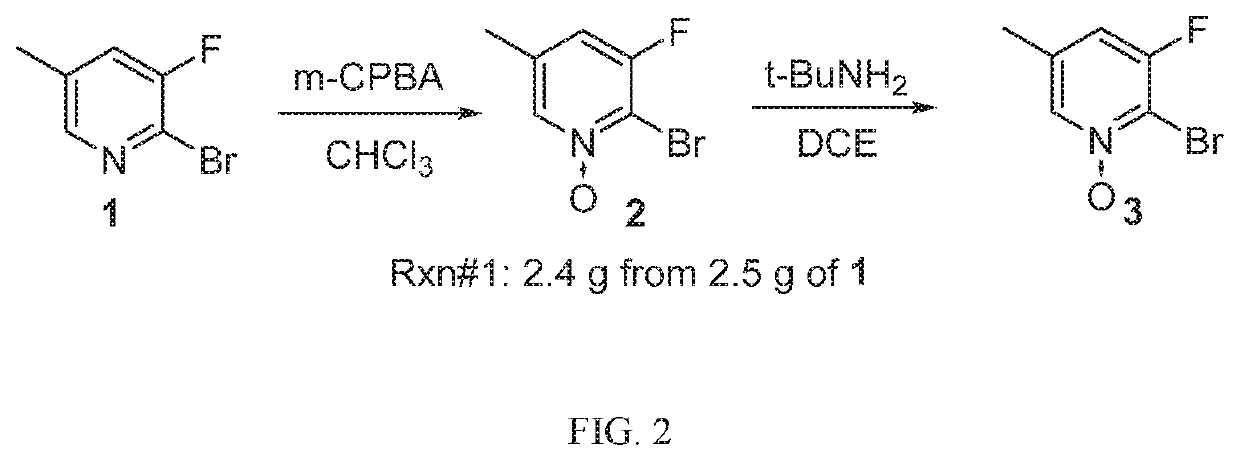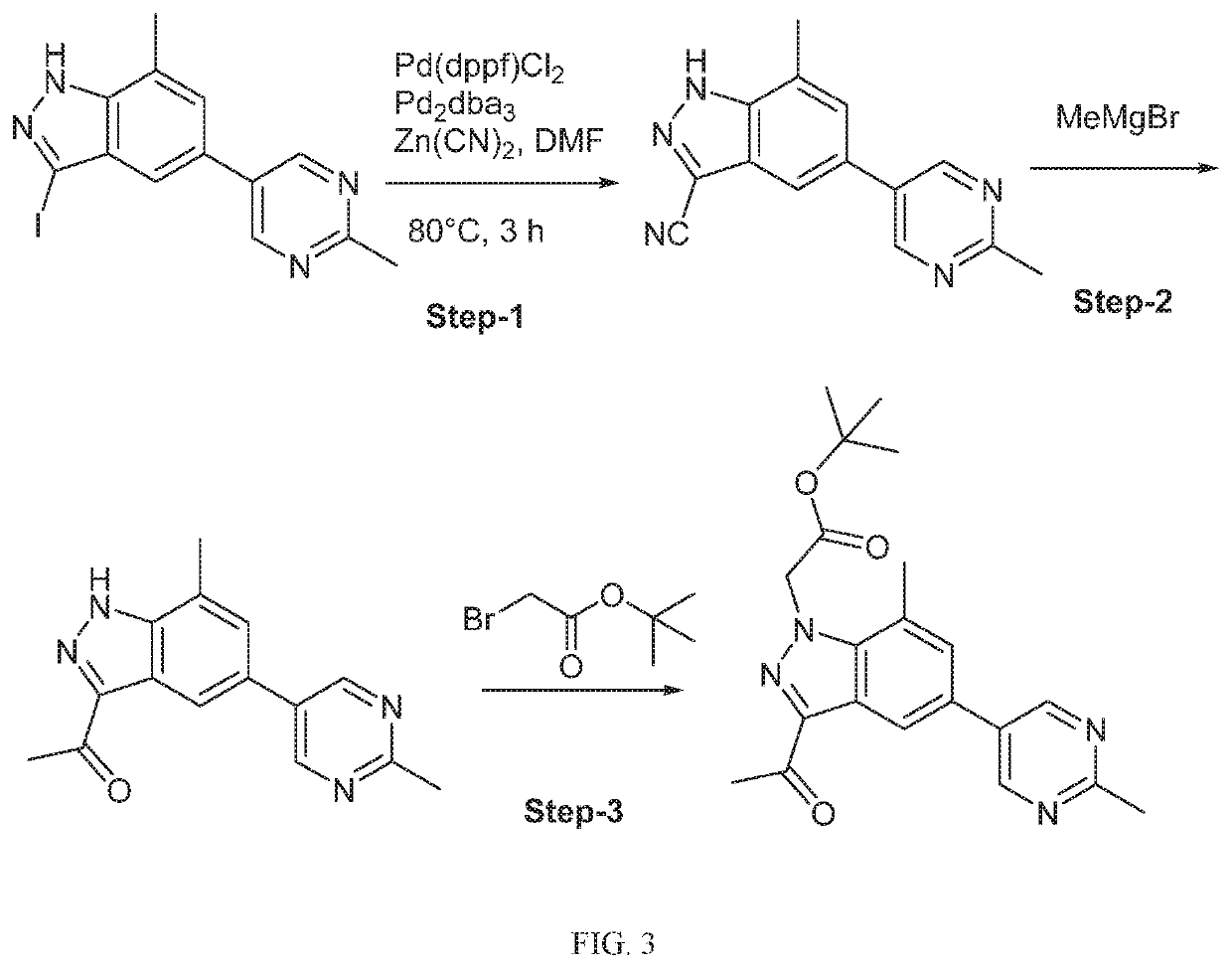Aryl, heteroaryl, and heterocyclic pharmaceutical compounds for treatment of medical disorders
a technology of aryl, heteroaryl and heterocyclic drugs, applied in the direction of group 3/13 element organic compounds, group 5/15 element organic compounds, organic chemistry, etc., can solve the problems of macular degeneration, vision loss, and h have a fivefold increased risk of macular degeneration, so as to reduce the possibility of bacterial infection
- Summary
- Abstract
- Description
- Claims
- Application Information
AI Technical Summary
Benefits of technology
Problems solved by technology
Method used
Image
Examples
example 1
oute of Synthesis
[1167]A compound of the present invention can be prepared, for example, from a central core. In one embodiment, for example, the central core Structure 1 is an N-protected aminoacid where X1 is nitrogen and PG=protecting group. In one embodiment, the central core is coupled to an amine to generate an amide of Structure 2 (wherein L-B includes a C(O)N moiety). Structure 2 can then be deprotected to generate Structure 3. Structure 3 is coupled to Structure 4 (A-COOH) to generate a second amide bond, forming a compound within Formula I. The chemistry is illustrated in Route 1.
[1168]
[1169]In an alternative embodiment, central core Structure 5 is reacted with a heterocyclic or heteroaryl compound to generate a compound of Structure 6. In one embodiment, Structure 6 is deprotected to generate a carboxylic acid, Structure 7. In one embodiment, Structure 7 is coupled to an amine to generate a compound of Formula I. This chemistry is illustrated in Route 2.
[1170]
[1171]In an ...
example 2.examples
Example 2. Examples of Central Synthons
[1189]
[1190]ZA is halogen.
[1191]In one embodiment, deuterated L-proline synthons are disclosed. Deuterated synthons include, but are not limited to, for example, the following compounds:
[1192]
[1193]Structure A can be treated with deuterium oxide to generate Structure B. See, Barraclough, P. et al. Tetrahedron Lett. 2005, 46, 4653-4655; Barraclough, P. et al. Org. Biomol. Chem. 2006, 4, 1483-1491 and WO 2014 / 037480 (p. 103). Structure B can be reduced to generate Structure C. See, Barraclough, P. et al. Tetrahedron Lett. 2005, 46, 4653-4655; Barraclough, P. et al. Org. Biomol. Chem. 2006, 4, 1483-1491. Structure C can be treated with Mitsunobu reaction conditions to generate Structure D. Structure B can be treated with DAST to generate Structure E. See, WO 2014 / 037480. Structure A can be treated with sodium borodeuteride to generate Structure F. See, Dormoy, J.-R.; Castro, B. Synthesis 1986, 81-82. Compound F can be used to generate Structure K....
example 3
on of Central-L-B Synthons
[1194]
[1195]Routes 1a, 1b and 1c.
[1196]In Route 1a, 5-azaspiro[2.4]heptane-4,5-dicarboxylic acid, 5-(1,1-dimethylethyl) ester, (4S)-, CAS 209269-08-9, can be prepared as described in Tandon, M. et al. Bioorg. Med. Chem. Lett. 1998, 8, 1139-1144. In Step 2, the protected azaspiro[2.4]heptane is coupled to an amine in the presence of an organic solvent, a base and a coupling reagent to generate an amide bond; the L-B moiety. In one embodiment, the amine is (3-chloro-2-fluorophenyl) methanamine. In one embodiment, the organic solvent is DMF. In one embodiment, the base is diisopropylethylamine. In one embodiment, the coupling reagent is HATU. In Step 3, the protecting group is removed. In one embodiment, the starting material is reacted with an acid in the presence of an organic solvent. In one embodiment, the acid is 4N hydrochloric acid. In one embodiment, the organic solvent is dioxane.
[1197]In Route 1b, (4S) 4-oxazolidinecarboxylic acid, hydrochloride is t...
PUM
| Property | Measurement | Unit |
|---|---|---|
| pharmaceutical composition | aaaaa | aaaaa |
Abstract
Description
Claims
Application Information
 Login to View More
Login to View More - R&D
- Intellectual Property
- Life Sciences
- Materials
- Tech Scout
- Unparalleled Data Quality
- Higher Quality Content
- 60% Fewer Hallucinations
Browse by: Latest US Patents, China's latest patents, Technical Efficacy Thesaurus, Application Domain, Technology Topic, Popular Technical Reports.
© 2025 PatSnap. All rights reserved.Legal|Privacy policy|Modern Slavery Act Transparency Statement|Sitemap|About US| Contact US: help@patsnap.com



